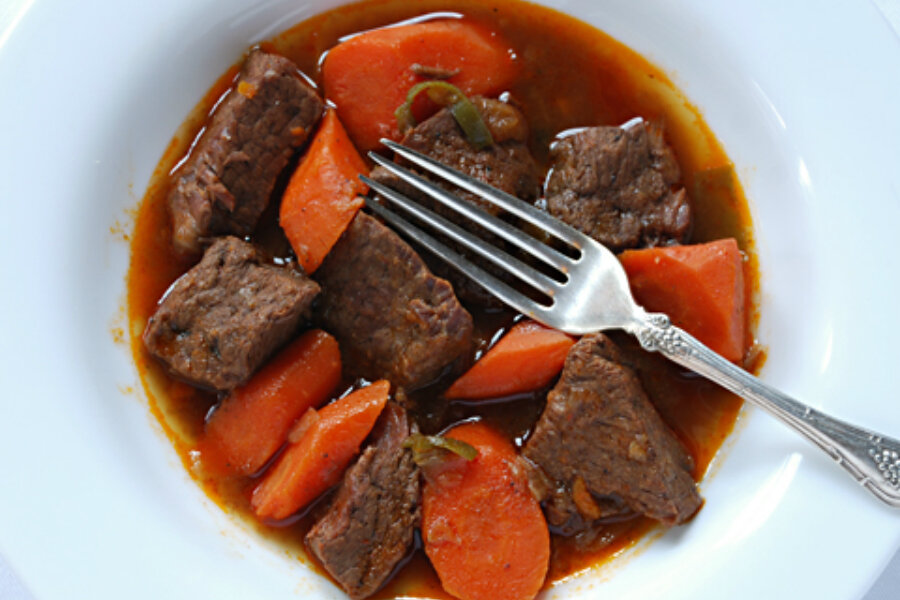Vietnamese beef stew blends flavors of multiple spices and cultures
Loading...
Sometimes I get these cravings. The other day the taste I wanted was a particular combination of beef and lemongrass and spice. And I wanted sauce, and plenty of it.
This is a recipe we’ve been tinkering with for years. The basic elements are aromatic and reassuring in a very Vietnamese style. Unlike true Vietnamese stews, this has a little soy sauce. Like Vietnamese dishes from the colonial period, you serve it with a good, crusty baguette, not rice, and you eat it with forks and spoons, not chopsticks.
It’s a very wet stew, and the ultimate sauce is an intermediate between the meat-clinging opacity of American stews and the liquid clarity of pot au feu. A big hot dish of big warm flavors will satisfy on a cold winter's night.
Vietnamese Beef Stew
Serves 4 to 6
2 pounds chuck roast, trimmed of fat and cut into one-inch cubes
1 stalk lemongrass, end trimmed off, dry outer leaves peeled away and the soft inner core minced
2 shallots, finely minced
a 1-inch piece of ginger, peeled, crushed and finely minced
3 cloves garlic
1 teaspoon fresh ground black pepper
1/8 teaspoon cayenne
2 teaspoons garam masala
1 teaspoon five-spice powder
2 teaspoons fennel seeds
3 tablespoons fish sauce (see Kitchen Notes)
1-1/2 tablespoons sugar
canola oil
1-1/2 cups low-sodium beef stock (see Kitchen Notes)
1 to 1-1/2 cups water
2 tablespoons soy sauce
2 tablespoons tomato paste
1 whole star anise
1 bay leaf
2 medium onions, peeled and sliced thin
2 jalapeño peppers, topped, seeded and coarsely chopped
1 pound carrots peeled, trimmed and cut in half-inch slices on the diagonal
a good baguette
1. Place the lemongrass, garlic, fennel seed, ginger, shallot, ground pepper, star anise, garam masala, cayenne, fish sauce and sugar in a big ceramic or glass bowl. Stir, then add in the chuck roast. Stir it all with your hands until every piece is coated. Cover and refrigerate for 30 minutes.
2. After 30 minutes, take the beef out of the fridge. Heat 1 tablespoon canola oil in a nonstick pan. Over medium-light heat, add the thin sliced onion and the diced jalapenos and saute for about four minutes. Then move the onion and pepper mixture to a deep heavy pot or dutch oven.
3. Add another tablespoon of oil to the pan. Working in batches, brown the beef. I usually do this in three batches. Each piece should be nicely browned on all sides. As the pieces brown, add them to the pot. Scrape all the little spice bits into the pot too. If any crust forms in the pan, deglaze it with a little stock or water and add that to the cooking pot too.
4. Then pour in the beef stock, water, tomato paste, and 2 tablespoons of soy sauce. Add the bay leaf and the star anise. Bring the liquid to a boil, reduce the heat to a gentle simmer, cover, and cook for about 90 minutes. Check occasionally.
5. After 90 minutes, add the sliced carrots, stir gently (see Kitchen Notes), cover again and cook about 30 minutes more.
6. Check the beef and the carrots. At this point, each should be very tender, and ready to serve.
7. Serve in a soup plate or shallow bowl, with baguette and butter, a leafy salad with a simple dressing.
Kitchen Notes
Watch out for the sodium. When using beef stock, if you are not using your own homemade, be sure to use low or no sodium, and even then be cautious. Soy sauce and fish sauce are each sodium bombs in and of themselves.
Star anise. Use whole star anise for this dish, not fragments. When you stir the pot, be gentle – you don’t want to break up the star anise. If you do, you’ll have to fish out all the little seeds and pieces before serving – those things, chewed on their own, are just too much.
Fish sauce. When choosing fish sauce, you will see there are many, many brands out there. As a rule of thumb, don’t buy a brand that comes in a plastic bottle. Buy the ones packaged in glass.
Some more traditional versions of this use turnips and even mooli (which is more familiar to us in the United States under the name daikon). We just like this with carrots, lots and lots of carrots. Indeed, one of our family members, who shall here go unnamed, hates carrots in every form except this one.
Related post on Blue Kitchen: Asian Turkey Burgers with Sriracha Mayonnaise







